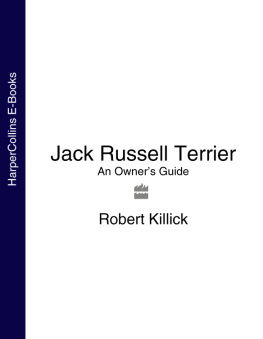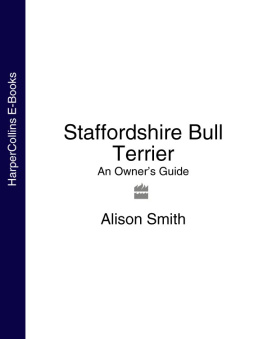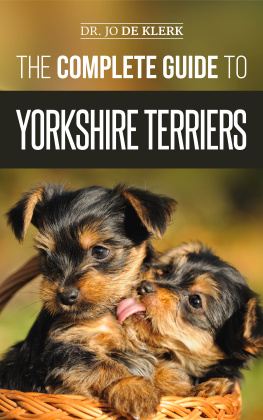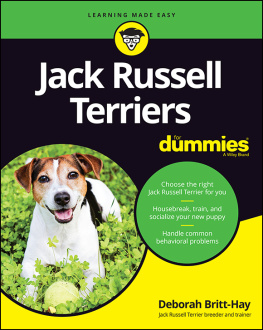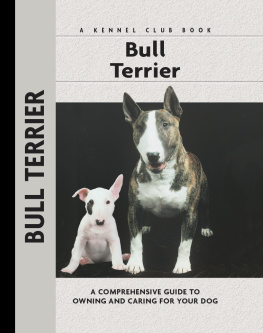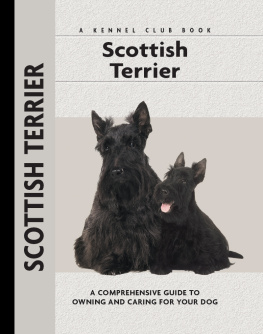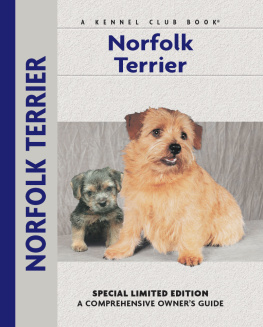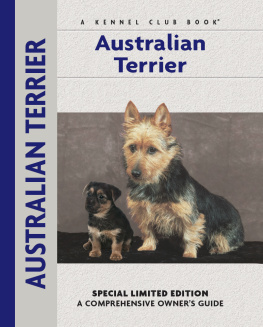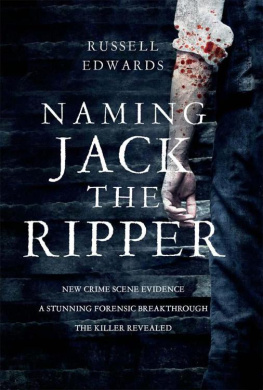This book is dedicated to my friend Clive Hoyle, a master breeder of Welsh cobs and working Jack Russell Terriers under his prefix Llangybi. I thank him for showing me the way with Llangybi Mister Chips, the most maddening but loveable Terrier Ive ever had, and Ive had a few!
The Breed Standard on is reproduced by kind permission of the Jack Russell Terrier Club of Great Britain. The publishers would also like to thank the following individuals for their help in producing the photography in this book: Barbara Hall and Alex Browne (Afinley) and their dogs. The author would like to thank the following: James Crowley, AKC, Caroline Kisko and her PA James Skinner of The Kennel Club, Kevin Horkin of the Pet Role Trust, Adrian Guthrie of the Jack Russell Terrier Club of Great Britain and Bill Roache, owned by four Jacks.
The section on docking is only a summary of the regulations and, as such, neither the author nor the publishers can take responsibility for its accuracy. Contact DEFRA for further details. We are grateful to the Council for Docked Breeds for their help in compiling the new docking regulations.
Dogs are referred to as he throughout to avoid he/she each time or the rather impersonal it. This reflects no bias towards males, and both sexes are equally valuable and easy to train.
Contents
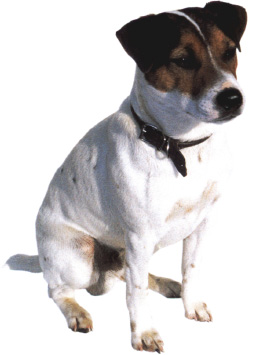
I feel well placed to write this foreword and was delighted to have been asked. The first thing that makes me suitable is my Jack Russell experience; everyone knows how demanding they are and to have one is a challenge well, I have four! Each one is totally different, in your face, bright as a button, ahead of the game and completely beguiling. I would not be without them. Secondly, I am suitable through knowing the author, Robert Killick. For some years we have worked together on dog charity projects at Crufts and it is not only his love of dogs but also his encyclopedic knowledge of them that has enabled him to write seven books. He is the right man to write this book and I commend it to anyone who wants to know the real Jack Russell.
Bill Roache MBE
The Jack Russell Terrier is one of the most important Terrier breeds because it has scarcely changed since its beginnings 150 years ago. Early photos and paintings show this to be true; indeed a photo of my dishevelled Jack Russell could be the litter brother to Trinity Jim, a famous Jack of around 1901. In this book we will present the quintessential modern Jack Russell from puppyhood through to adulthood.
I will be using the words Jack Russell because the average member of the public does not know or, I suspect, care about the split in the breed. Whether he is called a Parson Russell Terrier or a Jack Russell, the names are synonymous with a happy, small, vibrant dog whose fame has spread through Europe, Australia and America as a worker and showdog.
Arguments rage about this Terrier, particularly his size, but a real Jack Russell is a running machine, slim, muscular with legs in proportion to his body the short-legged round Terrier is not a proper Jack Russell.
Of all the many Terriers I have owned and bred in 35 years, my Jack Russell is the most intelligent and affectionate dog Ive ever had his zest for life is remarkable. He is not noisy or quarrelsome but he is self-willed and not easy to train. However, success will reward your patience and kindness. In the home he is good with children, playful and amusing, and, as a bonus, he is a great guard dog no sound escapes him. As a country dog, he will walk you until you fall over and then want more. As a working Terrier he has no equal, being feisty, courageous and persistent, and yet he is flexible and will be at home in the town or city with sufficient exercise and mental stimulation.
The breeds creator, Reverend John (Jack) Russell, was a legend in his lifetime, his Terriers were his legacy and they are a legend in our time.
Robert Killick
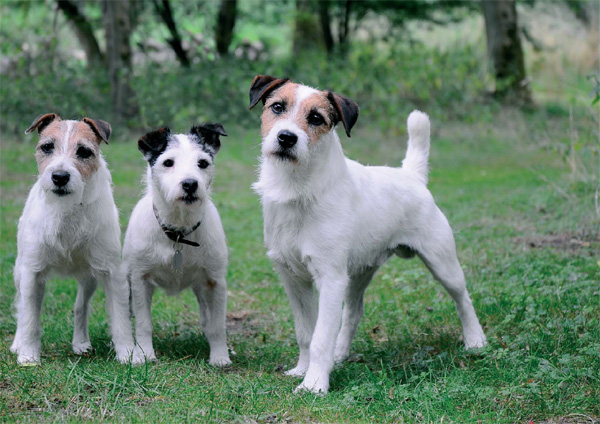
Owning a dog is a huge responsibility but an extremely rewarding one. When you decide to welcome a Jack Russell Terrier into your home, you have to consider not only how he will fit into your lifestyle but also what you can offer him in return. He will need regular exercise, feeding, games and companionship as well as daily care.
There are two strains of the same breed, which are prevalent in Great Britain. The Parson Russell Terrier, which is officially recognized by the UK Kennel Club, is, largely speaking, a show dog and pet, although many are working dogs. The other strain, which is more numerous, is simply the Jack Russell Terrier, a working Terrier and also a pet, as recognized and supported by the Jack Russell Terrier Club of Great Britain. Both have their roots in the same stock, that of the Reverend John (Jack) Russell (17951883), who, from 1815 until his death, developed his own strain of hunt terriers which suited his style of hunting and the terrain over which he hunted.
Evolution of dogs
We will never know exactly how, why and when wolves morphed themselves into domestic dogs; it was part of the evolutionary process and could have been over a period of 500,000 years or more. Those of us blessed with a vivid imagination can picture in our minds a family of primitive men sitting round a fire eating the results of the days hunt. The glittering eyes of wolves can be seen watching from the bushes, waiting for the bones that will be tossed into the undergrowth. Wolves, being intelligent, realized that primitive man was a source of food, and because they went hunting as a group, they would skulk along behind the humans in the hope that when they killed their prey there might be enough left over for them.
Early Man may have thought of wolves as a source of food they were edible, especially when young. Primitive children may have liked the look of wolf puppies when they were brought back to the cave as living store food, and perhaps they found that the puppies kept them warm at night, so they kept them and became attached to them. Slowly, over many years, the two species came to trust each other and Primitive man realized that domesticated wolves could help him find his prey and then kill it. With their superior hearing, they also made good guard dogs, warning of the approach of any other humans or animals, and this type probably became sheep and cattle dogs as men became agronomists. The early association between primitive man and wolves has been proved by the discovery of wolf bones found buried with human ones, dating back 500,000 years old.
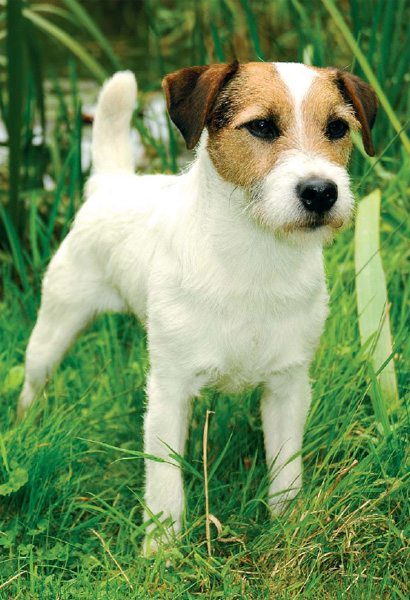
The Parson Russell Terrier is easily recognizable with his longer legs. Like all Jack Russells, he is an excellent ratter and loves to scent and hunt in the garden or countryside.
Selective breeding
We know that breeds of dog were bred for specific purposes even in ancient times and were respected in many early civilizations in the Middle East, ancient Egypt and China. An enormous number of ancient artefacts depicting dogs have been found in what are now Iraq and Iran as well as the Egyptian pyramids. It is not easy to recognize which breeds are portrayed in these ancient sites, mainly because they were not as sharply defined as they are today. Canophilists can find aspects in early statues and frescos of heavy war dogs, slim hunting dogs and small companion animals, but they seldom identify terriers because they probably did not exist in any way as we know them nowadays.
Next page
